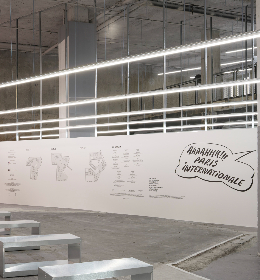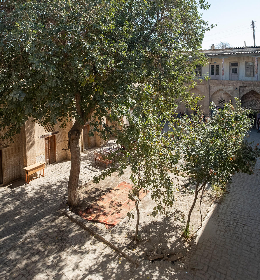The exhibition, titled "Allí, sin ser un lugar determinado, ni aleatorio; Como el puro ser donde no hay nada" ("There, a place neither precise nor random; Like pure being where there is nothing"), revolves around the theories on emptiness developed by the Buddhist monk Nāgārjuna (2nd-3rd century). His philosophy suggests that every object and being is defined by its emptiness, not void, but rather the interconnectedness of things and beings to exist. Nothing exists independently (cf. Ringu Tulku Rinpoche).
With this concept in mind, the exhibition invites us to discover Dávila’s works. Upon entering, we encounter Encuentran un Lugar en el Mundo (Y Dudan En Otro Mundo) [They Find a Place in the World (And Doubt in Another World)], a hanging installation of radios and speakers randomly broadcasting ever-changing channels. It is therefore impossible to follow a frequency in a continuous and logical way; we are faced with impermanence and randomness.
Probably the most striking work in this exhibition, Esperan en Lugares Donde Viven Mientras Esperan (They Wait While They Live Where They Wait) features small pieces of volcanic rock suspended from transparent threads, sketching a cube. Only the edges are outlined, allowing the viewer to project themselves in front of the cubic volume. Here again, the idea takes precedence over the formed and finished shape.

El Escenario se Coloca Y se retira (The Stage Is Set And Removed) is a frieze of LED screens counting down the age of the sun (left of centre) and its remaining lifespan (right), reminding us of the finite nature of our existence, as that of the universe and stars. This fatal countdown in real time also reminds us that without the sun, human life will also disappear.
Visualising this countdown is a stark reminder of humanity’s and the planet’s ultimate deadline.

A final piece, Instructions to/from the center of the universe, consists of fourteen copper engravings inspired by the map drawn up by astronomer Frank Drake in 1972. This map shows the Earth’s position in relation to fourteen pulsars, neutron stars rotating on their axis. Dávila depicts these pulsars using their galactic and terrestrial coordinates, calculated according to the solar system of reference. The artist also represents binary pulsars (or double pulsars), i.e. a pair of stars, one of which is a neutron star. Pulsars, being transmitters through the regular pulses they send, can be landmarks in the immensity of space.
Pablo Dávila invites us on a journey that is both intimate and universal, where visitors become aware of their infinite smallness in the face of the infinitely vast. At a time when climate issues and even scientific theories, especially those related to climate, are being called into question, the artist’s work seems essential in helping us visualise the invisible and the imperceptible on a human scale
"Allí, sin ser un lugar determinado, ni aleatorio; Como el puro ser donde no hay nada"
The Pill
On view until 13 December 2025
Photos: © Rebecca Fanuele










